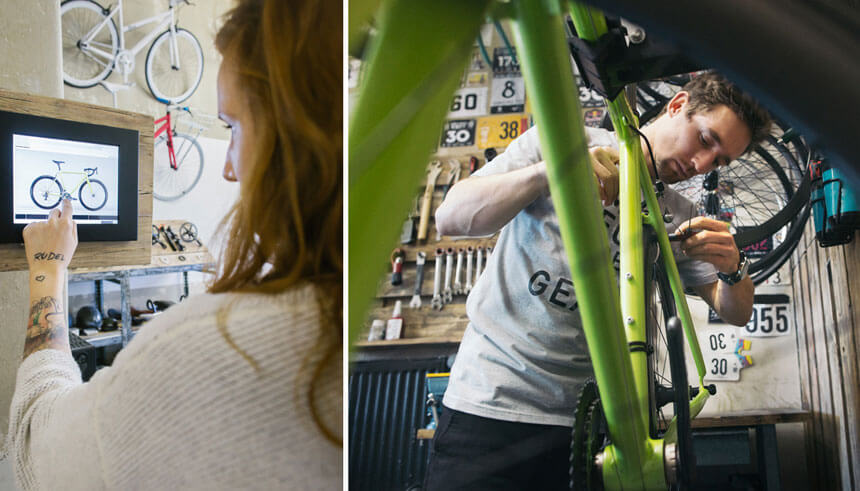US-Asia Business
Using Customization and Personalization to Gain Customers
By Angela Bao

How customizable products and personalized services can attract consumers in the US and China.
Consumers—especially Chinese millennial consumers—are becoming more demanding. Living in a digitally connected world, consumers are more aware of the products available and what other people are buying. As a result, some have become more discerning about the products they purchase and expect more from brands, in both services and product offerings. Deloitte found that 36 percent of consumers expressed interest in purchasing personalized products or services; one in five of those consumers were willing to pay a 20 percent premium on such products and services. In China, consumers are becoming more sophisticated and increasingly demanding personalized products over mass offerings. Customization and personalization are great ways for companies to engage with existing customers and tap into new demographics. Here is how businesses can integrate these tactics into their products and services, and capitalize on the next generation of consumers.
Customized product offerings
Millennials, Chinese or otherwise, value experiences, self-expression and discovery over material goods—but that doesn’t mean the two can’t go hand-in-hand. Eager to engage with brands and showcase their individuality, millennials are looking more and more to customizability. Brands from Nike to Coca-Cola have tapped into millennials’ sense of individuality by introducing customizable products and have achieved great success. Not only can it increase sales, customization gets consumers engaged with the brand because they are working with the company to create a unique product.
“The younger generation of Chinese grew up in a time where individuality and personal identity are increasingly important,” explains Charlie Gu, CEO and cofounder of marketing agency Kollective Influence. “Increasingly, they want something different—which shows that they have sophisticated taste—rather than follow the general trend.”
Gu says that customization and personalization of products is increasingly how brands “create that connection” with their audience and can be especially useful in markets such as China’s. He emphasizes that customization doesn’t have to mean fully bespoke—it can be something as simple as engraving a person’s name onto a lipstick case, or simply allowing consumers to choose from a selection of color combinations. Luxury leather goods company Coach started Coach Create to let clients customize their bags with monogramming and various accessories, such as bag charms, scarves, and removable shoulder straps. French cosmetics brand Guerlain started offering customizable lipsticks, where the client could pick and choose their own combination of the case and lipstick color. Even Coca-Cola allows people to personalize their own Coke bottles with any name, as part of their ongoing “Share a Coke” campaign.
“For businesses, one of the important questions is the balance between customization and the brand identity,” says Gu. If a business is mass-market and built on low-cost products, then customization might not make sense. On the other hand, if a company has a more niche audience, offering customization as another tier of products could benefit them. Offering customizable products increases operating costs for a business, so determining whether customization fits into the overall brand strategy is imperative.
A relatively low-cost customization strategy is what Gu calls the “module” approach, which Guerlain and Coach both utilized. Instead of making a unique product from scratch for each customer, a company can just offer several component options that can be mass-produced and easily assembled. “Give customers choices, and then let them choose—customization within a framework,” he advises. “It doesn’t actually require any customization of the actual product. The consumers are essentially just picking their own color, but to them it feels totally customized.”
Personalized services
Personalization isn’t just limited to products—it can also be applied to marketing and services. Consumers—Chinese millennials in particular—have high demands for excellent service that include personalizing product selections to each individual and feeling like the brand values them as more than just a customer.
“Customers want a unique shopping experience; they want to have a personalized connection with the brand, not just with the merchandise,” shares Gu. He suggests utilizing consumer data to customize marketing and user interfaces to tailor the way the brand interacts with the consumer.
“Customers want a unique shopping experience; they want to have a personalized connection with the brand, not just with the merchandise.”

Luckily, data is relatively easy to obtain from the younger generations. According to the Deloitte study, millennials are also more willing to give up their personal data if it means they can get more personalized products or services in exchange. Seventy percent of millennials don’t mind retailers tracking their browsing habits to receive personalized communications, and 28 percent who preferred personalized messages also expressed stronger brand loyalty. For smaller businesses that don’t necessarily have the capacity for large-scale data analysis, Practical Ecommerce recommends giving customers a simple survey to help determine preferences.
“Brands are increasingly using data such as purchase history to look back and say, ‘hey, this is something you like,’” says Gu. “And then based off of their purchase history and interest, they’ll provide some personalized recommendations.”
That level of personalized service is even permeating brick-and-mortar stores. Both Nike and Coach offer their product customization services online and offline, but some are opening concept stores that create more seamless online-to-offline integration. Nike opened Nike Live in Los Angeles, which the company describes as a “digital-meets-physical retail pilot” that will offer styles curated for each city’s preferences, determined by NikePlus members’ online shopping data. Retail giant Nordstrom is expanding its Nordstrom Local “service hubs” (launched in October 2017), which are service-oriented, inventory-free storefronts that aim to make customers feel like VIPs. At Nordstrom Local, customers can get alterations, make free appointments with personal shoppers, get manicures and pedicures, drop off their dry cleaning, and more.
“It’s no longer just about the merchandise itself,” Gu says. “It’s also the process of shopping. People believe the way we shop should also be a unique personal experience.”
Localized marketing
In China and the United States, product preferences are going to vary region to region. Gu states that it’s important for businesses to customize their approach to each local audience, and, if possible, even tailor their product offerings to that local audience’s tastes.
Gu uses China as in example. In Tier 1 cities such as Shanghai and Beijing, he says consumers are much more sophisticated; therefore, offering customized products would make more sense, because those people are more experienced shoppers, and are more likely to want something exclusive and individualized. However, in China’s Tier 2 and Tier 3 cities, tastes still might lean toward logo-heavy or brand-recognizable products. “I think a very important factor is the cultural preferences and behavior. What is the customization that a consumer is looking at?” Gu explains. “So having different ‘tiered’ offerings in your product is also important. Unless you’re a super niche brand and only focusing on a very small demographic, I think you really have to have that customization.”
It’s important for brands to integrate personalization into their marketing strategies, as well. “If a brand truly wants to think about customization for Chinese audiences, you need to think about how you also showcase that in your communications strategy and how you communicate to them,” he emphasizes.
That’s why Gu recommends that brands implement social media influencer strategies because they are essentially customized marketing channels. Especially for smaller influencers, these people already have dedicated followers that are specific to them, know what their audience likes, and are already proficient at communicating with them in a way that the audience appreciates.

